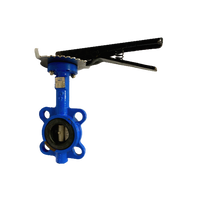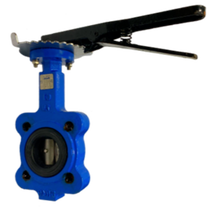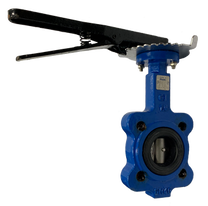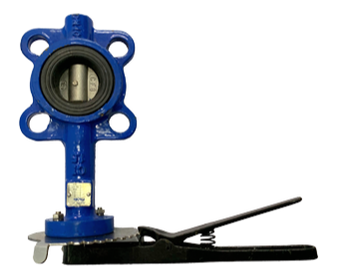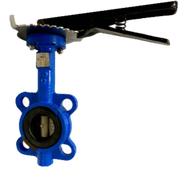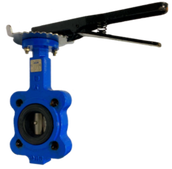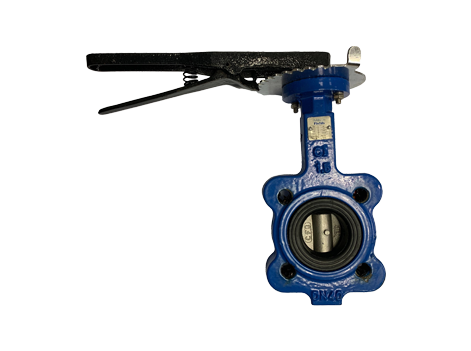|
|
Butterfly valves are designed as quarter-turn valves and used to regulate or isolate fluid flow in systems. Butterfly valves operate similar to ball valves as the handle requires a 90 degree pivoting to control the valve. Butterfly valves are low pressure valves mostly used in many industries due to its reduced cost and body mass. Butterfly valves are also applied in systems when there’s a need for cleaning, repair, or maintenance check. Butterfly valves are available in sizes ranging from 1 1/2” to 6” (DN40 – DN150). The maximum working pressure for butterfly valves is 150 PSI and they are made from cast iron. They are connected using ANSI 150# Flange End. |
Material Specification |
|
Connection Type |
|
Size |
|
Working Pressure |
|
Butterfly Valves Specifications
To learn more about individual product specification, please read the details below:
1. What are Butterfly Valves?
|
A butterfly valve is a type of valve that regulates or isolates fluid flow in systems. The butterfly valve is a type of quarter-turn valve used to regulate flow in pipeline systems. It is produced following the API 609 standards and inspection and testing of the valve is done according to the API 598 standards. Butterfly valves are used for solid liquids applications and can withstand a maximum pressure of 150 PSI.
Butterfly valves are available in sizes between 1 1/2” to 6” or DN40 to DN 150. Butterfly valves are made from cast iron which reduces the cost price of the product, however, to increase the corrosion resistance of the valve, the external body is painted blue. Also, the valve seat is made from EPDM material, increasing the sealing rate and avoiding leakages during operation. |
2. Why it is called Butterfly Valves?
The butterfly valve has a closing device which is a disc connected to a rod. The valve shuts off when the rod spins the disc in a 90-degree twirl to a vertical direction to the flow path. After the valve is opened, the disc turns back to enable the fluid flow.
Butterfly valves are uniquely designed as it has major characteristics such as lightweight, reduced cost, rapid operation, a wide variety of sizes, and installation footprint. Butterfly valves are controlled using automatic actuators, manual handles, or gearbox.
Butterfly valves are uniquely designed as it has major characteristics such as lightweight, reduced cost, rapid operation, a wide variety of sizes, and installation footprint. Butterfly valves are controlled using automatic actuators, manual handles, or gearbox.
|
The major parts of the butterfly valve include the seat, disc, actuator, and body.
|
3. How does a Butterfly Valve work?
Butterfly valves are simple to operate and this can be done manually via the gear and handle or automatically via hydraulic, electric, or pneumatic actuators. These methods give the valve an accurate disc rotation from fully opened to fully closed positions.
Of all three, manual operation via the handle and gear is considered the most economical and cost-effective means. Also, it allows an easy operation of the valve. The well-known methods of operation are gear and hand lever which are explained below:
Automatic actuation is another method of regulating butterfly valves via a remote. These actuators allow the operation of huge valves easily and possible. They are available in fail-open or fail-close designs. The fail-open design allows the actuator to remain open as a stand-by during actuator failure while the fail-close design allows the actuator to remain closed in case of failure. The actuators are also packaged with a manual actuation method as a substitute for any failures. Automatic actuators are available in three different types. They are:
Of all three, manual operation via the handle and gear is considered the most economical and cost-effective means. Also, it allows an easy operation of the valve. The well-known methods of operation are gear and hand lever which are explained below:
- Gear: the gears operate using a gearbox for increased torque at the cost of reduced speed of opening or shutting off the valve. For preference sake, position indicators can be attached to gears and they are commonly used for larger sized valves.
- Hand Lever: these are suitable for small valves and can be fastened to a fully opened, partially opened, or fully closed state.
Automatic actuation is another method of regulating butterfly valves via a remote. These actuators allow the operation of huge valves easily and possible. They are available in fail-open or fail-close designs. The fail-open design allows the actuator to remain open as a stand-by during actuator failure while the fail-close design allows the actuator to remain closed in case of failure. The actuators are also packaged with a manual actuation method as a substitute for any failures. Automatic actuators are available in three different types. They are:
- Electric: the electric actuators control the valve by rotating the valve stem via an electric motor.
- Pneumatic: Pneumatic actuators use compressed air for the piston or diaphragm movement which regulates the valve.
- Hydraulic: hydraulic actuators use hydraulic pressure for the piston or diaphragm movement which regulates the valve.
4. What are the two body styles of Butterfly Valve?
Butterfly valves can be connected to systems using different methods. The end connection type is ANSI 150# Flange End. The most common forms of connection are Wafer type and Lug type which are explained below:
|
This is a highly cost-effective and common type and it is placed in the middle of two flanges. The wafer type valve is designed in a way to own a flange hole outside the body. These flanges are joined to the valve through long blots that intersect the body of the valve. These two equipment's sealing is done by combining the gasket, O-ring faces, and flat valve. This connection is to achieve the valve's sealing against bidirectional differential pressure and avoid the reverse flow of fluids during operation. While replacing the valves, the entire system connected is recommended for a total shutdown.
|
|
The lug type of butterfly valve is designed with threaded inserts outside both sides of the body. Lug types have a reduced running pressure level and are suitable to use in dead-end service. Unlike the wafer type, the lug type's replacement can be done ion dependently without a total shutdown of the system. Primarily, 4 to 6 lugs are used for a single pipe section connection, however, the complete set has about 8 to 12 lugs. Also, the lug is capable of withstanding the mass of the pipes connected to the valve.
|
5. What is the use of Butterfly Valves?
Butterfly valves are used in various applications and can effectively function in slurry and large volume water systems. Some of the applied areas of butterfly valves include:
Butterfly valves have many benefits when connected to system installations. These are:
- Power generation
- Fire protection
- Vacuum service
- Compressed air and gas systems
- Oil and chemical industries
- Water supply and wastewater treatment.
Butterfly valves have many benefits when connected to system installations. These are:
- Easy and swift control: The 90-degree design of the butterfly valve handle gives a full opening and closure always. For larger valves, the gears and handwheels are joined to the stem, which generally eases operating the butterfly valve.
- Lesser space requirement: The butterfly valve is very compact and light-weighted. This makes it suitable for application in areas with space constraints.
- Minimizes cost: The material used in the production of the butterfly valve makes it require less cost. More so, the wafer type is an economical butterfly valve that can be used to connect two flanges.
BUTTERFLY VALVES CATALOGUE

